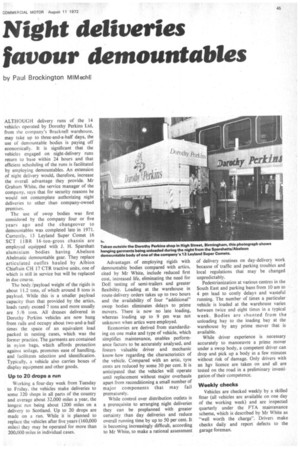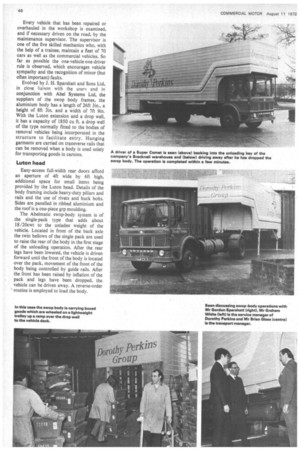Night deliveries
Page 47

Page 48

If you've noticed an error in this article please click here to report it so we can fix it.
favour demountables
by Paul Brockington MIMechE
ALTHOUGH delivery runs of the 14 vehicles operated by Dorothy Perkins Ltd, from the company's Bracknell warehouse, may take up to three-and-a-half days, the use of demountable bodies is paying off economically. It is significant that the vehicles engaged on night-delivery runs return to base within 24 hours and that efficient scheduling of the runs is facilitated by employing demountable& An extension of night delivery would, therefore, increase the overall advantage they provide. Mr Graham White, the service manager of the company, says that for security reasons he would not contemplate authorizing night deliveries to other than company-owned premises.
The use of swop bodies was first considered by the company four or five years ago and the changeover to demountables was completed late in 1971. Currently, 13 Leyland Super Comet 16 SCT 11BR 16-ton-gross chassis are employed equipped with J. H. Sparshatt aluminium bodies having Abelson Abelmatic demountable gear. They replace articulated outfits hauled by Albion Chieftain CH 17 CTR tractive units, one of which is still in service but will be replaced in due course.
The body /payload weight of the rigids is about 11.2 tons, of which around 8 tons is payload. While this is a smaller payload capacity than that provided by the attics, loads rarely exceed 7 tons and more usually are 5/6 tons. All dresses delivered in Dorothy Perkins vehicles are now hung from rails and occupy about two-and-a-half times the space of an equivalent load packed in nesting cases, which was the former practice. The garments are contained in nylon bags, which affords protection against soilage, promotes ease of handling, and facilitates selection and identification. Typically, a vehicle also carries boxes of display equipment and other goods.
Up to 20 drops a run Working a four-day week from Tuesday to Friday, the vehicles make deliveries to some 320 shops in all parts of the country and average about 32,000 miles a year, the longest run being about 1200 miles on a delivery to Scotland. Up to 20 drops are made on a run. While it is planned to replace the vehicles after five years (160,000 miles) they may be operated for more than 200,000 miles in individual cases. Advantages of employing rigids with demountable bodies compared with attics, cited by Mr White, include reduced first cost, increased life, eliminating the need for DoE testing of semi-trailers and greater flexibility. Loading at the warehouse in route-delivery orders takes up to two hours and the availability of four "additional" swop bodies eliminates delays to prime movers. There is now no late loading, whereas loading up to 9 pm was not unknown when artics were employed.
Economies are derived from standardizing on one make and type of vehicle, which simplifies maintenance, enables performance factors to be accurately analysed, and fosters valuable driver and mechanic know-how regarding the characteristics of the vehicle. Compared with an attic, tyre costs are reduced by some 30 per cent. It is anticipated that the vehicles will operate until replacement without major overhauls apart from reconditioning a small number of major components that may fail prematurely.
While control over distribution outlets is a prerequisite to arranging night deliveries they can be preplanned with greater certainty than day deliveries and reduce overall running time by up to 50 per cent. It is becoming increasingly difficult, according to Mr White, to make a rational assessment of delivery routines on day-delivery work because of traffic and parking troubles and local regulations that may be changed unpredictably.
Pedestrianization at various centres in the South East and parking bans from 10 am to 4 pm lead to costly delays and wasteful running. The number of times a particular vehicle is loaded at the warehouse varies between twice and eight times in a typical week. Bodies are shunted from the unloading bay to the loading bay at the warehouse by any prime mover that is available.
While driver experience is necessary accurately to manoeuvre a prime mover under a swop body, a competent driver can drop and pick up a body in a few minutes without risk of damage. Only drivers with an hgv licence are taken on and all are tested on the road in a preliminary investigation of their competence.
Weekly checks Vehicles are checked weekly by a skilled fitter (all vehicles are available on one day of the working week) and are inspected quarterly under the FTA maintenance scheme, which is described by Mr White as "well worth the charge". Drivers make checks daily and report defects to the garage foreman. Every vehicle that has been repaired or overhauled in the workshop is examined, and if necessary driven on the road, by the maintenance supervisor. The supervisor is one of the five skilled mechanics who, with the help of a trainee, maintain a fleet of 70 cars as well as the commercial vehicles. So far as possible the one-vehicle-one-driver rule is observed, which encourages vehicle sympathy and the recognition of minor (but often important) faults.
Evolved by J. H. Sparshatt and Sons Ltd, in close liaison with the users and in conjunction with Abel Systems Ltd, the suppliers of the swop body frames, the aluminium body has a length of 26ft 3in., a height of 8ft 3in, and a width of 7ft 9in. With the Luton extension and a drop well, it has a capacity of 1850 cu ft. a drop well of the type normally fitted to the bodies of removal vehicles being incorporated in the structure to facilitate entry. Hanging garments are carried on transverse rails that can be removed when a body is used solely for transporting goods in cartons.
Luton head Easy-access full-width rear doors afford an aperture of 4ft wide by 6ft high, additional space for small items being provided by the Luton head. Details of the body framing include heavy-duty pillars and rails and the use of rivets and huck bolts. Sides are panelled in ribbed aluminium and the roof is a one-piece grp moulding.
The Abelmatic swop-body system is of the single-pack type that adds about IS /20cwt to the unladen weight of the vehicle. Located in front of the back axle the twin bellows of the single pack are used to raise the rear of the body in the first stage of the unloading operation. After the rear legs have been lowered, the vehicle is driven forward until the front of the body is located over the pack, movement of the front of the body being controlled by guide rails. After the front has been raised by inflation of the pack and legs have been dropped, the vehicle can be driven away. A reverse-order routine is employed to load the body.




























































































